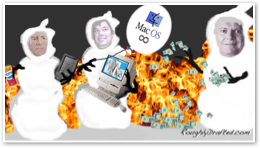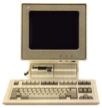
Platform Crisis: The Tentacles of Legacy
After reliance on isolationist development using proprietary technologies, the second factor of platform crisis involves embracing the suffocating tentacles of long term legacy support. Here’s how legacy plays into the past, present, and future plans of Apple and Microsoft, and what it means for users of their products.

Platform Death Match introduced the difficulty of launching a new platform and the work involved in maintaining one. This series looks at the historical march of computing platforms, to sort out why winners won and why losers lost. While the computing environment is always changing, the same basic rules are in effect today, and will shape the future developments between Mac OS X Leopard and Windows Vista.
Previous articles:
-
•1990-1995: Why the World Went Windows The smart strategies and dirty tricks used to establish the PC.

1990-1995: Platform Crisis: The Tentacles of Legacy
While Apple appeared to do everything wrong throughout the early 90s, Microsoft appeared to do everything right. On the surface, it looked like Microsoft was starting out with clean design that allowed it to offer features Apple was still struggling to deliver, including memory protection and preemptive multitasking.
Apple was embroiled in legacy issues. Everything about the Mac was mired in the original design decisions made back in the mid 80s, when system resources and processing power were far more limited.
The Mac’s shared graphics model meant it would be non trivial to solve the lack of memory protection for applications. That made it possible for third party applications and extensions to accidently overwrite memory used by the system or other applications, causing fatal system crashes and general instability.
Similarly, there was no simple way to tack on preemptive multitasking. If an application stalled or ran into an unrecoverable error, the system had no way to authoritatively stop it and safely hand control over to another application.
Apple could bolt preemption on the side, but it would be of no use to users of existing applications; app would all need to be entirely redesigned to take advantage of the feature. Major system components such as QuickTime would also need to be completely overhauled, a huge effort that would take years to complete.
Along with hardware support for an increasingly odd set of proprietary designs, the integrated Mac hardware and software system was stuck in a mess outdated methods, code, and protocols that each contributed toward system instability and slow performance, and hampered Apple's ability to actually solve any of the problems.
PowerPC Hardware
Despite the increasingly creaky underpinnings of the Mac System Software, Apple was able to update the Mac hardware and jettison a lot of architectural legacy in the process when it jumped to PowerPC.
In its partnership with IBM and Motorola, Apple was able to dump the 68k processor for an entirely new and forward looking architecture that vaulted Mac performance into the lead over DOS PCs using the Pentium processor. The Pentium ran hotter and slower and cost more to build due to legacy issues of its own.
PowerPC was supposed to serve as a replacement for the x86 PC. Microsoft worked with Motorola to port its new Windows NT 4.0 to PowerPC, and IBM delivered a new version of OS/2. Apple not only ported the Mac System 7, but also announced plans to deliver Copland as a true PowerPC native OS that would fly on the new hardware.
Legacy Hardware Decisions for PowerPC
The partners involved in PowerPC not only designed a new processor, but drew up plans for a reference platform for new PC hardware using the chip. The initial revision was called PReP, the PowerPC Reference Platform.
Ironically, this design incorporated much of the old legacy cruft of the existing x86 PC, including the 1970’s era Centronics parallel printer port. Apple in particular wanted the PowerPC platform to be more Mac-like, rather than a regression back into the old and outdated standards embraced by the PC industry.
The result was CHRP, the Common Hardware Reference Platform. Unlike the earlier PReP, CHRP standardized on a clean new firmware design called OpenFirmware, which had been designed by Sun for its SPARC workstations and released as an open standard.
PowerPC and CHRP were intended to solve legacy hardware issues for the PC industry, but instead, both were largely ignored because of legacy issues. Apart from Apple, no manufacturer had the power or the vision to offer anything new.
Apple Slowly Ditches Legacy Hardware
By the time CEO John Sculley was ousted from Apple in 1993, the company had to support a range of Mac models, each with a unique hardware architecture, and sold under an array of marketing names, including Performa, Centris, and Quadra.
Sculley had hoped to create a lineup of Macs models with names that sounded like Sony products or luxury cars, but the plan instead created confusion. What’s the difference between a Quadra 630 and a Performa 630? It wasn’t obvious for consumers.
After Sculley’s departure, steps were taken to simplify both marketing and hardware designs. The first generation of Apple’s PowerPC Macs were largely just old Macs with a new processor; the existing product lineup of the 68k based Quadra 610/700/800 became the PowerMac 6100/7100/8100.
By 1994, Apple had dropped both the Centris and Quadra names, making everything a PowerMac apart from the convoluted Performa brand, which assigned a unique model number to every configuration. The PowerMac 6100 was sold as the Performa 6110, 6112, 6115, 6116, 6117, and 6118CD. It’s no wonder Sears couldn’t sell them.
In 1995 Apple launched the second generation of PowerMacs, which began incorporating modern hardware conventions of the newest PCs, including PCI expansion slots.
 A decade after Texas Instruments’ NuBus and IBM’s MCA, Intel introduced PCI as its own auto-configuring expansion slot standard to replace the PC’s Industry Standard Architecture.
A decade after Texas Instruments’ NuBus and IBM’s MCA, Intel introduced PCI as its own auto-configuring expansion slot standard to replace the PC’s Industry Standard Architecture. PCs using ISA required manual and often problematic configuration of IRQ lines, I/O addresses, and DMA channels whenever a new device was installed. Mac users didn’t even need to know what an IRQ was.
NuBus had made Mac expansion cards far more elegant to use, but also more expensive to buy than the simpler but more troublesome ISA cards. Apple was able to immediately move its Macs to PCI and instantly create a shared market for PCI cards that could be used in both Macs and new PCs. NuBus was dropped entirely.
On the PC, support for PCI was added to motherboards next to ISA slots so users could have the worst of both worlds: IRQ management headaches from the 80s, paired with a splintered market for the new PCI cards. After all, if all PCs have ISA slots, but only the newest ones have PCI, why not continue to manufacture ISA devices?
More Decisive Changes
After realizing the benefits of simplicity and forward technical momentum, Apple stepped up its efforts to clean up its legacy hardware. After buying NeXT, the newly focused Apple began work on a clean new hardware design for the Mac, referred to as the NewWorld Architecture.
Introduced with the iMac in 1998, the new design dropped remnants of the past and adopted ideas from CHRP, including a clean and complete implementation of OpenFirmware. Apple scuttled the old Mac serial connectors and ADB keyboard ports and standardized on Intel’s new USB.

A year later, Microsoft’s approach to PC legacy was a new coat of paint. It devised a color code for Centronics parallel ports, serial ports, analog joystick ports, and PS/2 mouse and keyboard ports, so users could match cables to the old legacy ports with less confusion.
Microsoft also documented its insistence that PC makers stop using ISA slots and begin using USB. A half decade later, PCs are just beginning to standardize on USB, and Microsoft continues to sell PS/2 keyboards. PCs also still continue to use BIOS firmware and the MBR disk partition map from the early 80s.
The Two Edged Sword of Legacy
Abandoning legacy hardware enabled Apple to move decisively into the future. It kept the company alive through a difficult transition, and paralleled other actions of the new Apple to dismiss old ideas in market positioning, technology, development, operations and sales.
PowerPC gave Apple an infusion of new performance that helped ameliorate the crisis of its inability to deliver a new software platform. Simplified operations enabled the company to focus on fixing real problems rather than just ineffectually putting out constant fires. Killing legacy helped to save Apple.
Conversely, embracing legacy had helped to keep Microsoft alive. While often used as a derogatory word in technology, the other side of legacy is compatibility and the market power of an installed base.
Microsoft developed its platform using legacy as a key strategy. Rather than initially delivering an elite, expensive solution that required new hardware, Microsoft sold Windows to existing DOS users.
Microsoft frequently compromised ongoing Windows development to bend over backward to support existing DOS and 16-bit software. It provided support for a broad range of hardware, including old outdated interfaces that still represented the majority of what people were actually using in the PC world.
While Apple was trying to move its developers to a new software platform and migrate users to PowerPC hardware, Microsoft was working to make sure that old DOS and Win-16 applications would run on both NT and 95, and that even old PCs could be adapted to run as low powered Windows Terminals.
Dueling Business Models
That difference between Apple and Microsoft is not just a philosophical stance, but reflects the two companies’ differing business models:
-
•Apple makes its money selling hardware, so it was always in that company's interests to sell the best hardware possible and make sure its Macs offered features and performance ahead of bargain PCs. Hardware quality and the user experience were valued over high volume, low margin sales because that's what enriched Apple.
-
•Microsoft makes its money selling software licenses, so it embraced the idea of selling new software for old hardware, running old applications on a new version of Windows, and selling copies of Windows for PCs of any price. Volume was valued over hardware quality and user experience because that's what enriched Microsoft.
Today, those same legacy factors and business models are still in place. That's why Apple is unlikely to ever make major market share gains across most of Microsoft's established business, but its also why Apple is well positioned to cherry pick the most valuable segments of the market and offer the best product to users able to make a choice.
It also complicates Microsoft's ability to take Apple on directly. Vista carries so much baggage from Windows XP and the wide swath of third party software it has to accommodate, that Microsoft is left without the ability to move quickly and decisively to match Apple's moves.
Microsoft has become the same lazy dinosaur that Apple had turned into in the early 90s.
This Series










Monday, November 27, 2006







 Bookmark on Del.icio.us
Bookmark on Del.icio.us Discuss on Reddit
Discuss on Reddit Critically review on NewsTrust
Critically review on NewsTrust Forward to Friends
Forward to Friends
 Get RSS Feed
Get RSS Feed Download RSS Widget
Download RSS Widget





